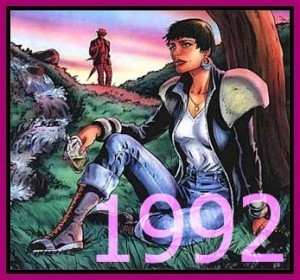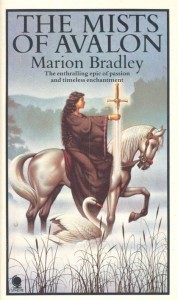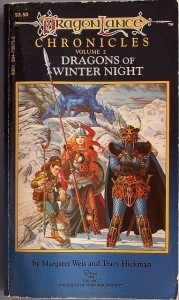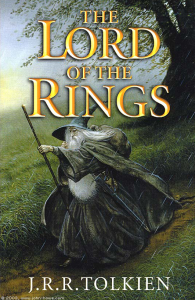Tansy Rayner Roberts's Blog, page 78
June 20, 2013
Friday Links: This Week Fortnightly
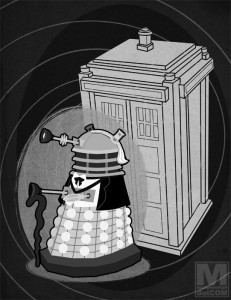 I wasn’t here last week! So here are two weeks worth of links. Deep breath, we’re going in.
I wasn’t here last week! So here are two weeks worth of links. Deep breath, we’re going in.
The outrageous hoax (well, it has to be) that 90 missing episodes of Doctor Who have been found safe and well somewhere in Africa continues to keep Doctor Who fans from clawing each other’s eyes out over who will succeed Matt Smith, which is… good, right? No link to this one, because I first heard it from a bloke in a bar (hi Mondy!) If it’s true obviously it would blow everyone’s minds, but the potential for heartbreak is too high to give it a moment’s attention. Moving on…
Kate Elliott did a series of tweets today on the subject of #SFcivility, working through some thoughts she has had in the wake of NK Jemisin’s groundbreaking GOH speech about a Reconciliation in the science fiction community, and particularly in response to the criticisms by some that Jemisin was not sufficiently polite. It’s nice to see that it is in fact possible to be articulate on Twitter when you put a bit of thought into it – Kate’s tweets have been Storified and are worth reading in full.
Justine Larbalestier, whose PhD makes her eminently qualified to make this statement, comes in with We Have Always Been Fighting This Fight, about the women who have been part of science fiction and fandom since the beginning, and yet have always been announced as if they are unusual, or the first to make themselves seen.
Speaking of Storified Tweets, I also really enjoyed @quarridors’ take on the lack of diversity in blockbuster movies. Good stuff, Nat!
Oh and for more NK Jemisin, check out the new pre-season episode of Galactic Chat, which has been revamped with a new team who are all keen as mustard to bring entertaining SFF book related interviews to you, the listener.
Geek Feminism compares Iron Man 3 with Star Trek: Into Darkness and can’t quite believe that Iron Man is the more feminist film. Seriously, who saw that coming?
Faith Mudge challenges the idea that modernised, revamped fairytales are the feminist versions of the stories and points out that the original stories are plenty feminist, thanks very much.
Bitch Magazine recommends some of the best comedy podcasts by women, and looked at the current hot topic of the lack of female lead characters in video games.
Speaking of which, Anita Sarkeesian got some charming responses when she tweeted a response to the fact that none of the games presented at Microsoft’s Xbox One E3 press conference featured female protagonists.
This is one of the best responses yet to the idea that the boom in YA books aimed at girls is leaving boys with nothing to read.
Locus spotlights Australia’s own Deborah Biancotti – a great interview! I’m excited to read Deb’s novel/s when they finally make their way out into the world.
June 19, 2013
The Mists of Avalon [I Got Epic in my Fantasy]
 So, this is the year of the mass re-reading for me.
So, this is the year of the mass re-reading for me.
The Mists of Avalon by Marion Bradley (originally printed without that fantastical ‘Zimmer’ middle name of hers) is one of the rare books in my reading history that I hold as a sacred text without actually having spent at least a decade re-reading it every year or two.
A few months ago, on Galactic Suburbia I revealed that while I love that book dearly, I’ve never gone back to reread it, and I think that’s largely because it’s such a massive paperback that it’s a) daunting and b) my copy is cracked so badly that I don’t dare open the book again. One of our listeners promptly sent me an e-copy of Mists of Avalon to read on my Kindle.
Normally I have mixed feelings about being gifted books – on the one hand, SHINY, but on the other hand, PRESSURE TO READ IT STRAIGHT AWAY AND HAVE AN OPINION OMG.
However, the timing was good. I was in an epic fantasy mood, and trying desperately to hold off reading the third Game of Thrones book as long as possible, so somehow I did actually find myself reading Mists of Avalon. Ahem, though I did stop halfway through in order to mumblefinishtheGameofThronesbooks.
So, Mists of Avalon. It honestly doesn’t feel like twenty years since I was last there.
There’s something incredibly refreshing about epic fantasy told from the point of view of women – it’s not that it’s a better way to tell a story but it’s different, and considering how many times the Arthurian cycle has been retold, anything new is good. It’s still a story about war and politics and danger and men, we just don’t have to see the world through the eyes of those men.
I also enjoyed the nuance in the characters – none of them are wholly virtuous or villainous (except perhaps the entirely perfect Galahad whom I assume everyone just wants to slap). And while I remember this book as being substantially about the way that the patriarchal Christian religion swept away the more egalitarian pagan/Druidic traditions, there’s a lot more to it than that – in particular, the book shows many of the more positive and appealing facets of Christianity at this time, and also challenges the idea that the pagan/Druidic traditions were free from gender issues and sexism.
 The women of this book are complicated and fascinating: Igraine, the high queen who was born in Avalon and ended her life in a nunnery; Viviane, Lady of the Lake who is trying desperately to secure her society’s traditions in the face of a New Era; Morgause, ambitious and deeply protective of her many sons; Gwenhyfar, stricken with anxieties and desperately unhappy despite being perhaps one of the most “privileged” and high ranked women in the land, and throws herself more deeply into the comfort of piety as she grows older and feels guiltier about her “sins.” Niniane, the young Lady of the Lake who constantly feels as if she is not good enough. Nimue, Lancelot’s daughter and the ‘future’ of Avalon. And of course, Morgaine.
The women of this book are complicated and fascinating: Igraine, the high queen who was born in Avalon and ended her life in a nunnery; Viviane, Lady of the Lake who is trying desperately to secure her society’s traditions in the face of a New Era; Morgause, ambitious and deeply protective of her many sons; Gwenhyfar, stricken with anxieties and desperately unhappy despite being perhaps one of the most “privileged” and high ranked women in the land, and throws herself more deeply into the comfort of piety as she grows older and feels guiltier about her “sins.” Niniane, the young Lady of the Lake who constantly feels as if she is not good enough. Nimue, Lancelot’s daughter and the ‘future’ of Avalon. And of course, Morgaine.
The strength of the characters is partly why I remember this book so clearly, and Morgaine is a brilliant example of this. An intelligent, flawed, stubborn and angry woman surrounded by a society for whom her main value is marrying and bearing children – and quite awfully, after devoting her early years to becoming a most excellent priestess at Avalon, it turns out that what they want from her is also to bear a child. She’s rarely motivated by malice or wickedness (though who would blame her) and yet everything she does moves her closer to her fate to be That Morgan Le Fay, the destroyer of Arthur. When she does finally embrace her role as enemy of Arthur, it is hard-won and believable, and that negative energy rebounds quite disastrously on her, making it less and less possible that she can turn back from her path.
The fact that the story takes place over such a long period of time also means we get many older and old women in the story, often taking the lead of action and events, which is something I would absolutely like to see reflected in more modern epic fantasy.
 As well as being being a novel from the point of view of The Ladies, Mists of Avalon also has lots of knights, swords, armour and gore in it. Also some terrifying childbirth scenes, and a deep, believable infusion of magic. The magic in this novel is wonderful and I think is worth considering in the light of NK Jemisin’s excellent essay “But, but, but — WHY does magic have to make sense?“. The magic that Morgaine learns is deeply emotional and untamed, and while she is capable of great power at times, this power is also affected by her environment and her feelings. A good example of this is the way that she finds herself shut out of Avalon, unable even to raise the small amount of magic to summon the mists and find her way home, for as long as she is still suffering the anger of how Viviane betrayed her by setting her up to bear a child to her brother.
As well as being being a novel from the point of view of The Ladies, Mists of Avalon also has lots of knights, swords, armour and gore in it. Also some terrifying childbirth scenes, and a deep, believable infusion of magic. The magic in this novel is wonderful and I think is worth considering in the light of NK Jemisin’s excellent essay “But, but, but — WHY does magic have to make sense?“. The magic that Morgaine learns is deeply emotional and untamed, and while she is capable of great power at times, this power is also affected by her environment and her feelings. A good example of this is the way that she finds herself shut out of Avalon, unable even to raise the small amount of magic to summon the mists and find her way home, for as long as she is still suffering the anger of how Viviane betrayed her by setting her up to bear a child to her brother.
The book does a brilliant job of showing how important religion has always been to the events of English history and myth, and that we could do with more nuanced depictions of religious experience in fantasy world-building. Like the magic in the novel, everyone has a different relationship to the religions of the day, and deals differently with the rising power of the Christian Church over the older traditions. Some genuinely convert, others do so reluctantly, some rebel, and others are ambivalent enough that it makes little difference to them to mouth the Christian words as indeed they may have done with the Druidic rituals. Again, the long time period of the novel allows this to be shown across many characters, and how it is different for them at different points in their lives.
 Another social detail that I felt was explored substantially was the fostering system among the upper and royal classes, and the new family ties that this formed as well as the old ones that it damaged. In Morgaine’s case we see the pros and cons of this situation – she is able to go on with her life without dealing with the immediate consequences of her unplanned pregnancy outside marriage, with her Aunt Morgause taking on the role of Gwydion/Mordred’s upbringing. Women who do not feel naturally materal have options other than raising their children themselves. On the other hand, it is strongly implied that Morgaine would not necessarily have chosen to give Gwydion up without Morgause’s manipulations. Likewise, the fostering system does not help the miserably childless Gwenhyfar until much later in life. Lancelet always felt a distance from his mother Viviane thanks to being fostered away from her as a child, and a similar situation leads to a tragedy between Balin and Balan, foster brothers who come to literal blows over a misunderstanding involving their birth mothers. It’s very clear that this is an essential aspect to medieval culture that had significant ramifications, and I liked very much that there was not a presumption in the text that the blood relationships would always be the most important kinds of familial connections between characters. As of course becomes supremely relevant as the tragedy of Arthur never having been able to form a relationship with his son becomes his kingdom’s downfall…
Another social detail that I felt was explored substantially was the fostering system among the upper and royal classes, and the new family ties that this formed as well as the old ones that it damaged. In Morgaine’s case we see the pros and cons of this situation – she is able to go on with her life without dealing with the immediate consequences of her unplanned pregnancy outside marriage, with her Aunt Morgause taking on the role of Gwydion/Mordred’s upbringing. Women who do not feel naturally materal have options other than raising their children themselves. On the other hand, it is strongly implied that Morgaine would not necessarily have chosen to give Gwydion up without Morgause’s manipulations. Likewise, the fostering system does not help the miserably childless Gwenhyfar until much later in life. Lancelet always felt a distance from his mother Viviane thanks to being fostered away from her as a child, and a similar situation leads to a tragedy between Balin and Balan, foster brothers who come to literal blows over a misunderstanding involving their birth mothers. It’s very clear that this is an essential aspect to medieval culture that had significant ramifications, and I liked very much that there was not a presumption in the text that the blood relationships would always be the most important kinds of familial connections between characters. As of course becomes supremely relevant as the tragedy of Arthur never having been able to form a relationship with his son becomes his kingdom’s downfall…
When I was a teenager still coming to grips with the fantasy genre, this book blew all my preconceptions about gender and epic fantasy out of the water even before I realised I had them. To take the knights and ladies of mythology and make them such real, flawed, grubby people takes guts.
Mists of Avalon still holds up today as an elegant, powerful historical fantasy novel which charts the rise and fall of an empire in a single volume.
Sure, it’s pretty big but SINGLE VOLUME, PEOPLE.
The twenty or so Mists of Avalon sequels and prequels, of course, did not happen.
What’s your favourite fictional take on the Arthurian legend?
June 17, 2013
Thirtysomething Years in the TARDIS [WHO-50—1994]
 So as it turns out, I never watched the version of “Thirty Years in the TARDIS” that was televised for the 30th anniversary of Doctor Who in 1993, or indeed the expanded-for-VHS version that was released in 1994. When the recent DVD release of this documentary (packaged with Shada and a bunch of good extras) was announced, I assumed it was something I had seen before. All the other Doctor Who podcasters seemed to remember it, and it sounded like the sort of thing I would have watched.
So as it turns out, I never watched the version of “Thirty Years in the TARDIS” that was televised for the 30th anniversary of Doctor Who in 1993, or indeed the expanded-for-VHS version that was released in 1994. When the recent DVD release of this documentary (packaged with Shada and a bunch of good extras) was announced, I assumed it was something I had seen before. All the other Doctor Who podcasters seemed to remember it, and it sounded like the sort of thing I would have watched.
However, when I listened to the excellent Radio Free Skaro interview with Kevin Jon Davies, the producer and director of the documentary, it began to dawn on me that actually, this thing they were all talking about, I’d never actually seen it. Or if I had, I remembered almost none of it.
So finally I sat down to watch the thing with my family – and as I should have predicted, 8 year old Raeli was mostly uninterested in it beyond calling out the names/numbers of the respective Doctors when they appeared on screen, while 3 year old Jem was rapt.
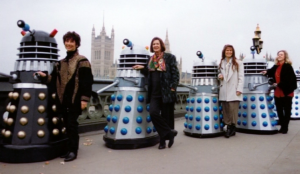 It was lovely to see so many faces, and detailed pieces from so many interviews. It had the benefit of nostalgia that came with Dimensions in Time, but without nearly so much of the embarrassment factor!
It was lovely to see so many faces, and detailed pieces from so many interviews. It had the benefit of nostalgia that came with Dimensions in Time, but without nearly so much of the embarrassment factor!
One of the most interesting and I suppose unusual elements, for a documentary, was the staged ‘scenes’ which used many of the Doctor and companion actors, sort of (but not always) in character. Some of these were recreations of classic location shots (honestly, how many times have they taken Daleks across that bridge now??) and others illustrated effects shots that the show itself had never achieved, but potentially could in the future – Daleks flying like they do in the comics, a scene featuring more than three Daleks at a time thanks to CGI as well as models, and famously the shot at the end in which a small boy opens the door to the TARDIS and the camera follows him in directly to the console room.
 I very much liked the interviews with Elisabeth Sladen and Gerry Anderson that included their children (though I had to stifle a sob when Raeli said gravely that Elisabeth Sladen’s daughter Sadie must be very sad now) and the fact that the documentary looked at the effect of the show on viewers as well as the people making it behind the scenes – though the random celebrity choices were a bit odd and are now extremely dated. A little explanation at the beginning as to who they were and WHY they were talking about Doctor Who would have been useful for the re-release.
I very much liked the interviews with Elisabeth Sladen and Gerry Anderson that included their children (though I had to stifle a sob when Raeli said gravely that Elisabeth Sladen’s daughter Sadie must be very sad now) and the fact that the documentary looked at the effect of the show on viewers as well as the people making it behind the scenes – though the random celebrity choices were a bit odd and are now extremely dated. A little explanation at the beginning as to who they were and WHY they were talking about Doctor Who would have been useful for the re-release.
Colin Baker’s Doctor received the least attention – sadly the character had not yet been renovated in the eyes of fans, and this probably didn’t help, as they included interview footage with Colin discussing his intentions to make the character less likeable in contrast with Peter Davison, but didn’t examine anyone else’s involvement in that season (except for a little bit of Eric Saward in another section defending his violent scripts) which did rather leave you with the impression that the failings of the Colin Baker season were entirely the actor’s responsibility.
The bit where Colin Baker & Nicola Bryant are followed by Cybermen down the steps near St Paul’s Cathedral is pretty cute, though.
All in all, the documentary felt like a far more appropriate anniversary celebration than Dimensions in Time, and it had a genuine enthusiasm to it. Thanks to Doctor Who Confidential, and a bunch of other material, we’re completely spoiled now for behind the scenes material, and it’s hard to imagine a time when a documentary like this was such a rare, impossible treat.
 When we got to the end, the children both looked unsettled, as if they hadn’t expected it to be done yet, and I then had to explain that it was made before the 8th, 9th, 10th and 11th Doctors had even been imagined.
When we got to the end, the children both looked unsettled, as if they hadn’t expected it to be done yet, and I then had to explain that it was made before the 8th, 9th, 10th and 11th Doctors had even been imagined.
19 years ago, a prediction of Doctor Who not only coming back, but becoming as substantial a success as it is today, would have not sounded particularly convincing. Nevertheless, the documentary More Than 30 Years in the TARDIS is awash with hope, and helpful suggestions, never once giving up on the idea that Doctor Who had a future.
The viewers, however, would have to wait a bit longer before that was anything close to true.
ELSEWHERE ON 1994:
Introducing the Missing Adventures [NZDWFC]
Back to the Land of Fiction/Conundrum by Steve Lyons [The Doctor Who Book Club Podcast]
Shakedown: the return of the Sontarans [Tardis Wikia]
PREVIOUSLY:
Back from Outer Space
The Splendid Chaps hosts in their sartorial finery.
I’m almost recovered from my flying visit to Melbourne.Livia Day had an awesome time on Friday at the Sisters in Crime dinner. I wish I had a chance to go to more of these events, it sounds like they have a ball (especially when they roll out their legal/police presenters). And man, do those ladies love books.
I hadn’t met my fellow authors Josephine Pennicott & Poppy Gee but the organisers had wrangled copies of our books to be sent to each other which meant we had LOTS to talk about as soon as we saw each other. Lindy Cameron did a fantastic job with the Q&A, making it very clear how much she had read and researched of our work too.
The highlight was probably when Poppy started talking about the real life Tasmanian murder that partly inspired her novel, and Josephine pulled out a newspaper clipping from that murder which she just happened to have in her collection…
Alex and I had more of a cruisy catch up day on Saturday, though I had time to run out and meet Tsana and her lovely husband Lewis for coffee in the morning, and then in the afternoon we zipped off to Collingwood to hang out underneath a pub with some lovely Doctor Who people and a whole bunch of very tall microphones.
Splendid Chaps was seriously the most fun ever. Just like podcasting only with REAL PEOPLE WHO I DIDN’T IMAGINE IN MY HEAD! I was delighted to meet Ben McKenzie & Petra Elliott in person and to remind myself that John Richards is one of my favourite people. Plus I got to meet the adorable Zenny, who had so many smart things to say. Also, we were both wearing TARDIS inspired outfits! (anyone who has pics of us, please send them my way, I ended up with hardly any on my phone!)
The episode goes up on the 23rd and I don’t want to spoil it or anything but if you know anything about the Colin Baker era of Doctor Who, you know what the musical number is. OH YEAH BABY. Now think how hard it would be to get a musician willing to do a cover of That Song.
Also, it is totally worth it to get along to one of the Splendid Chaps live shows if only to see what Petra is wearing. In this case, a candy pink 80′s jacket, a plastic bubbleskirt dress, and curly hair! If she doesn’t turn up for the 8th Doctor episode in an opera gown I will be very disappointed… but it was Ben who took the sartorial cake by sporting a very elegant and comfortable looking version of the Sixth Doctor’s coat – which turned out to belong to Our Grant, and was made by his Mum.
The funny part was that every time Ben put the coat on, he found himself ColinBakering – grasping his lapels, pulling faces, putting his hands on his hips and basically channeling the Sixth Doctor. Don’t mess with that coat, people! It was apparently responsible for at least 50% of the performance…
A lovely evening followed as we had dinner with the cast and crew of the show, plus assorted friends, talking madly about King Kong, Doctor Who and all manner of things.
By lunchtime on Sunday I was back in the arms of my family, sharing out airport presents and being leaped upon by small (and tall) children. A great trip, but I am quite glad it was so short – my girls missed me!
June 12, 2013
Find Me in Melbourne!
 My jetsetting Melbourne weekend is about to begin!
My jetsetting Melbourne weekend is about to begin!
I will be appearing as Livia Day alongside two other Tasmanian crime writers, Poppy Gee and Josephine Pennicott, at the Something Rotten in the Apple Isle event on Friday evening, 14 June: The Rising Sun Hotel, cnr Raglan St & Eastern Rd, South Melbourne.
Then in my other guise as Tansy-from-Verity I shall be appearing at the Splendid Chaps Live Show: Six/Clothes on the Saturday afternoon. There will be prizes for Doctor Who themed clothing and cosplay. Book now!
June 10, 2013
Dimensions in Time [WHO-50—1993]
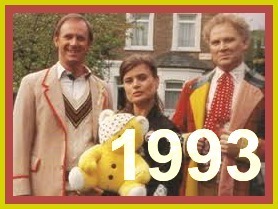 And you think YOUR thirtieth birthday was a bit of a letdown…
And you think YOUR thirtieth birthday was a bit of a letdown…
So, Dimensions in Time. It’s on YouTube. You can watch it right now if you want to. In fact, I’m going to embed it in a minute.
Reviled (and occasionally warmly defended) by most Doctor Who fans, and a source of great embarrassment for most of the actors involved, this 30th Anniversary Special (the beginning of a relationship between Doctor Who and the charity Children in Need) sees all available Doctors and companions – well. They sort of battle the Rani, really, across Albert Square (location of popular British soap opera EastEnders) and a few different time zones. It’s not GOOD by any definition of television quality or making-sense-ness but it is occasionally charming and adorable.
I’d never seen it before I watched it for this blog post. Don’t ask me how I missed it or indeed avoided it over the last twenty years. I just – did.
Some historical context: at this point, Doctor Who had been “rested” for four years, and showed no sign of returning.
A proper dramatic TV special had been mooted, The Dark Dimension, involving multiple Doctors and directed by Graeme Harper, but it came to nothing. The fact that this special was never made means that it is basically the Special What-Might-Have-Been Leaf of Doctor Who fandom, containing all that is perfect and desirable in a Doctor Who anniversary. So, no pressure there, Dimensions in Time. How do YOU hold up?
So. My commentary, upon watching Dimensions in Time for the first time:
PART ONE
1) Before it even starts, we have the framing narrative that is Noel’s House Party. This show is something of a retro cultural touchstone that I mostly missed out on, even withn the times I lived in England. Still, these bits are mostly good because he has Jon Pertwee (I. Am. The Doctor.) in the studio, being wonderful and claiming ultimate status as star of the show.
2) The Doctor predicts here that Noel Edmonds will still be on TV in 2010. Was this true, British readers? I’m pretty sure you had Graham Norton instead by then.
3) Is it possible that Noel Edmonds’ outfit was selected by John Nathan Turner? I can’t tell what that garnet actually is but I THINK it’s a vest painted on to a floppy white shirt.
4) Four arrives in a vortex with his grand Tomlike tones, same as ever except for the sad lack of curls. The use of costumes (particularly old costumes) in this is quite interesting, and I might focus on that in order to cope better with the production as a whole. Tom (he’s not really being Four, he’s just Tom but let’s face it, the border between the two is pretty thin) is wearing Logopolis red, and June Hudson should be proud to see the hat is still wearing well.
5) Tom Baker does not appear on location like the other Doctors or meet anyone else in this, taking the role of the NARRATOR DAHLING.
6) The disembodied heads of One and Two are seriously the best argument for never ever using CGI ever. For goodness sake. Why not use ACTUAL VIDEO FOOTAGE of their heads? If ever there was a call for a 5 second clip from an old story, this was it. Anyone who thinks the use of old footage in The Name of the Doctor was remotely, go watch this and then give yourself a STERN TALKING TO.
7) Also the Rani’s TARDIS has gone seriously downmarket since her first appearance back in Mark of the Rani, but I appreciate the fact that she has a painted toyboy as her lab assistant. Frankly the lack of this as part of her schtick was somewhat surprising before now.
 8) Seven and Ace!!! They are lovely, mostly because they’re completely Seven and Ace – it’s only been four years since these two have been on screen and Sophie Aldred in particular looks just the same. The ‘young’ Ace body language is still there and I quite like the way she randomly starts trying on clothes in the market.
8) Seven and Ace!!! They are lovely, mostly because they’re completely Seven and Ace – it’s only been four years since these two have been on screen and Sophie Aldred in particular looks just the same. The ‘young’ Ace body language is still there and I quite like the way she randomly starts trying on clothes in the market.
9) The cameos EastEnders characters is mildly breaking my brain, but I was in my time almost as bit an EastEnders geek as a Doctor Who fan (until the mean ABC stopped showing it in Australia!) so I will admit that it’s a bit good to see Kathy and Pauline sending themselves up.
10) I don’t know who Mandy or Big Ron are because they come from the After Times when we didn’t have EastEnders in Australia.
11) The premise of this story – the Doctor and companions caught in a time loop, randomly replacing each other as they attempt to make some sort of narrative sense of it all, actually is not too bad. Except that in practice it is, well, all a bit bad. It’s no Time Crash, people.
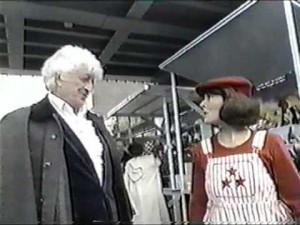 12) I will admit to fannish squee about some of the odd and unusual Doctor-companion combinations. And oh, the moment where Sarah Jane (bizarrely wearing an iconic outfit from the mid 70’s – but hey that makes a vague sort of sense for the plot!) sees HER Doctor and half skips across Albert Square to catch up to him… that’s rather lovely, that is. Elisabeth Sladen and Jon Pertwee on screen together, even for a few seconds, is worth everything.
12) I will admit to fannish squee about some of the odd and unusual Doctor-companion combinations. And oh, the moment where Sarah Jane (bizarrely wearing an iconic outfit from the mid 70’s – but hey that makes a vague sort of sense for the plot!) sees HER Doctor and half skips across Albert Square to catch up to him… that’s rather lovely, that is. Elisabeth Sladen and Jon Pertwee on screen together, even for a few seconds, is worth everything.
13) When Five turns up, he gets two companions instead of one. Is Mark Strickson not there because he’s off filming alligators in New Zealand, just like he always is when they want him for Big Finish?
14) I’m a bit worried about what this plot is suggesting about the imminent disposability of companions, especially when the Companion just got split into two for Peri and Nyssa. Five is looking pretty good, though, considering it’s ten years since he played the role. I am a little disappointed that Nyssa is wearing one of Noel Edmonds’ vests. No redemption for the progressive descent of her taste in clothes after 1981, then.
15) FIFI. Sure, this is a veritable smorgasbord of villains, using every monster costume and prosthetic they could muster, it’s actually slightly more impressive than The Pandorica Opens, or would be if the monsters and villains were actually doing anything other than wave from windows. But I’m ridiculously excited that Fifi from The Happiness Patrol is getting another outing and also, is alive again. So… who exactly kept Fifi in their cupboard ready for this eventuality? Hats off to them!
16) I lived in a London square once, and the fact that the park was always locked imprinted itself on my brain, so this part is very realistic to me.
CLIFFHANGER: I can’t believe people had to wait for the second half of this, which screened on the following night. That’s just cruel.
17) So the audience gets to decide the outcome – ie. Which EastEnders character gets to help the Doctor. Really, that’s all they get to decide? At the very least we should get to vote to bump someone off.
18) The opening credits, I noticed the first time as well, are speeded up as if even they are slightly embarrassed about what’s going on here.
19) The Rani’s earrings are extraordinary. I’m also quite impressed that Peter Davison is able to summon Jon Pertwee with his brain. Wouldn’t that be a creepy party trick if he could still do it now?
20) Liz Shaw! She’s quite ballsy in this, running up and attacking the Rani while Jon Pertwee cowers behind a fence. Unfortunately, some girls from EastEnders has turned up to scare her off. BOO, HISS! Hang, on, was that the Mandy bit? Was Mandy the girl who just frightened Liz Shaw away? I thought she was supposed to help!!! She just saved the flipping Rani instead.
21) Oh, they ALMOST gave Jon Pertwee a gratuitous helicopter scene! Instead he gets a climbing-into-a-helicopter scene. All the Pertwee bits are mostly excellent in this.
22) Yes yes, the Sixth Doctor meeting the Brigadier finally, all very historical, but it was done far better in The Spectre of Lanyon Moor. Oh dear I think I just realised why the Brigadier “recognised” the Sixth Doctor in the Spectre of Lanyon Moor. Headdesk.
23) Romana! I didn’t know Romana was in this! Lalla Ward is as aristocratic and confident, and her outfit is rather Romanaish. Good show. Glad she wasn’t stuck in a vortex with Tom this time. But why was she in a garage?
24) Frank Butcher, on the hand, is over-acting so hard his eyes almost rolled out of his head mid-sentence. Was he trying to win a prize?
25) Oh, Victoria. There are no words. *Sadly shakes head* I know Debbie Watling only played the part for a year like twenty five years previously, but I’m sure the real Victoria wasn’t this wet and also, why is she dressed like that when she was dropped off in 1960 and would have got to 1993 by the long road?
26) WHAT IS LEELA WEARING OH MY GOD. YOU HAVE THE ACTUAL GALLIFREYAN COSTUMES, I SAW THEM EARLIER, SO WHAT THE COMPLETE FUCK IS THIS? WAS SHE ON HER WAY TO A PETER PAN COSTUME PARTY?
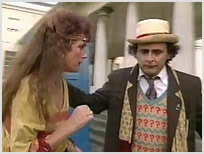 27) I am certain that Leela used to brush her hair.
27) I am certain that Leela used to brush her hair.
28) It’s somewhat endearing that Leela remembers being Romana and thus all the companions are one companion WHAT DOES THIS MEAN FOR THE SHOW?
29) Are all the companions actually projections of the TARDIS? Is that what they always were???
30) The ending is abrupt but it’s over, the Rani is defeated, and at least there’s Ace and Seven again as it should be, after everyone else has gone home. Tea, work, done.
CONCLUSION: Not as good as The Curse of Fatal Death. This odd duck feels a bit like everything negative everyone ever said about the JN-T era (I got this far without using the word pantomime!) is being staged as some colossal practical joke on the British public, and fandom in general. You never want anyone who dismissed Doctor Who as ‘for kids’ to see it and therefore have ammunition against you for the rest of your life.
But…
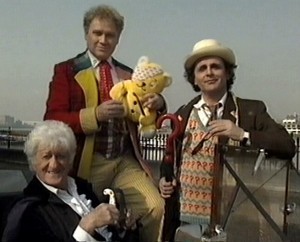 It’s also kind of funny and weird, and bonkers, and it was for charity. As far as last hurrahs go… well. For all the word ‘pantomime’ gets used against him as an insult, something positive I got out of the recent book about JN-T is that he put on some most excellent, Doctor Who filled stage productions and I for one would have LOVED to get a chance to see his Cinderella on stage with Peter Davison and Colin Baker and Nicola Bryant and the rest.
It’s also kind of funny and weird, and bonkers, and it was for charity. As far as last hurrahs go… well. For all the word ‘pantomime’ gets used against him as an insult, something positive I got out of the recent book about JN-T is that he put on some most excellent, Doctor Who filled stage productions and I for one would have LOVED to get a chance to see his Cinderella on stage with Peter Davison and Colin Baker and Nicola Bryant and the rest.
I can’t do that, but I can see this and it does feel at least a bit as if they were trying to make something that would make the fans of the show happy.
If nothing else, Dimensions in Time is an argument for Doctor Who always, always being given a decent budget. But if I can love The Chase and ship Leela/Andred and reclaim Tegan as a companion, then I can find it in my heart to love this broken little coat of many colours too.
But I love the Behind the Scenes footage more:
ELSEWHERE ON 1993:
Dimensions in Time [Wife in Space]
The Pit, AKA was this really the worst Doctor Who novel of all time? [The Doctor Who Book Club Podcast]
White Darkness [The Doctor Who Book Club Podcast]
PREVIOUSLY:
Epic List of Epicness: 50 Essential Epic Fantasies Part II
 Thanks everyone who came by Part I of the Epic List of Epicness, across four different blogs. If you missed it, check out the first 25 ‘Essential Epic Fantasies’ from Liz Bourke, Jared Shurin, Justin Landon and Tansy Rayner Roberts.
Thanks everyone who came by Part I of the Epic List of Epicness, across four different blogs. If you missed it, check out the first 25 ‘Essential Epic Fantasies’ from Liz Bourke, Jared Shurin, Justin Landon and Tansy Rayner Roberts.
The challenge was this: to make a list of 50 Essential Epic Fantasies, to be posted in two halves at the same time as other challengees.
The rules:
• No more than one book or series from each author (for example, Tolkien can go in for The Hobbit or The Lord of the Rings or the Silmarillion)
• No collections or anthologies
• You can only list books that you have read.
• Definition of “essential” and “epic fantasy” up to individual interpretation.
Now, PART TWO!
Check out the second 25 ‘Essential Epic Fantasies’ from Liz, Jared and Justin
26. Sabriel, Garth Nix (1995)
I fell in love with the darkness and weird, sneaky world building as the schoolgirl heroine crossed over a mysterious Wall into a frosty kingdom that would reveal the truth about her family and her destiny. Also, necromancy!
27. Mage Heart, Jane Routley (1996)
A Renaissance setting, and a young female protagonist who is lured into a world of courtesans, royal politics, necromancy (apparently necromancy was a thing in the mid-90’s!) and demons. Quite a lot of demons…
28. The Witches of Eileanan, Kate Forsyth (1997-2002)
This epic 6 book saga starting with Dragonclaw followed the red-haired twins Iseult and Isabeau as they tread different paths towards a single destiny: to restore the relationship between the land of Eileanan and the practitioners of magic. I’m a sucker for stories where the dominant form of magic is WITCHES rather than wizards or enchanters, and the rich use of Scottish mythology gives these books a strong sense of cultural identity.
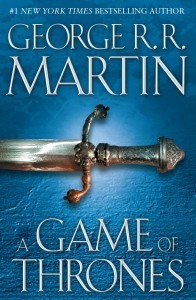 29. A Song of Ice and Fire, George RR Martin (1996-2011-?)
29. A Song of Ice and Fire, George RR Martin (1996-2011-?)
I don’t know if any of you are aware of this, but 1996 was quite a long time ago, and yet I only recently read the entire ASoIaF series over a couple of months. I was reading a truckload of books in 1996 (though that was the year I officially got bored with the genre for a while, and particularly started resisting epic series by male authors after breaking up with Robert Jordan around the third book of the Wheel of Time only to be told by a friend I hadn’t yet reached the point where it got good… TOO LATE!). Ahem. So when I started hearing that GRRM was the fantasy author who ‘got it right’ and ‘did things differently’ and that A Game of Thrones was the book most recommended to people who didn’t otherwise like epic fantasy… well, I ignored it, didn’t I, and kept on reading my female authors and Terry Pratchett.
Looking back, that was a pretty good life choice. I’m glad I started reading these books at 34 instead of 18, and not just because of the massive wait between every volume. Reading them now, in the context of the TV series and the upswell of popularity, has been pretty cool, but I hate to think how I would have coped back then. Anyway, I’ve said a lot about these books already recently. Yes, they’re essential in an understanding of modern epic fantasy as a genre. But that doesn’t mean I’m going to tell you that you should read them…
Yes, that’s a baby bump. You just don’t get this stuff in epic fantasy all that often…
30. Xena (1995-2001)On the other hand, if you don’t love Xena, I wash my hands of you.
I’m kidding. Really. I have close friends who don’t get Xena, and I still love them. But I will defend this show to the death for its subversiveness, its humour, its characters, its fight scenes and its amazing New Zealand cast and crew who produced something extraordinary. Not only that, but looking at the 6 year run of Xena as a whole, I see a substantial epic fantasy arc that broke more traditions and skirted as many boundaries as any old Game of Thrones books. Our heroine follows a dark and messy redemptive arc despite the fact that she herself (and many people around her) don’t believe it is possible for her to be redeemed for her dark deeds of the past. Despite this, she makes friends, finds a soulmate, kicks butt and goes fishing. Sometimes there’s singing.
The ‘everything (mostly) BC is good’ policy led to a complex a surprisingly coherent mythical world which was largely based around Ancient Greek and Roman traditions, but made room for Chinese, Japanese, Mesopotamian, British Celtic, Indian, Christian, Arthurian, Norse and Egyptian mythology too. Xena made a few cultural sensitivity gaffes along the way, but they were trying hard to be inclusive, and the visual diversity of this show – with prominent use of Maori, Samoan and African-American actors in key guest and background roles – is something that would be lovely to see reflected in far more epic fantasy fiction.
31. Ash: a Secret History, Mary Gentle (2000)
I’ve seen arguments accepted that this book is science fiction, and I have no problem with that (though it stretches thin) and it is absolutely alternate history as well (or indeed, as included within the definition of science fiction) BUT I’m claiming it for epic fantasy too, and not just because it’s awesome. Gorgeous writing, and a powerful, historically-realistic look at what it actually takes to fight medieval-style wars. Anyone who thinks a woman could not lead men in battle has not read this book.
 32. Crouching Tiger, Hidden Dragon (2000)
32. Crouching Tiger, Hidden Dragon (2000)
My last ‘media’ entry, this movie blew me away when I first saw it, with its gorgeous scenery, angsty heroes, spectacular fight scenes and elegant, understated magic. I knew little about Chinese history and mythology beyond what I learned from the Monkey! TV series (which was a major show in Australia in the 1980’s! All us ABC kids watched it along with The Goodies and Doctor Who) and I found this movie massively effective and inspiring. My first response was to run, not walk, to find the novels that the movie was based on, and I was beyond excited to discover this was adapted from the third of a five part fantasy epic by Wang Dulu (published between the 1930’s and the 1950’s. And then I found out that this five part fantasy epic was not translated into English. And then I was sad.
It was probably the first time I ever became aware of how important translation is to works being recognised outside their own countries. Which may say more about me than the publishing industry, but it was a pretty essential revelation.
33. The Last Hero, Terry Pratchett (2001)
In December 2001, I was travelling through Europe. I saw the first Harry Potter movie and the first Lord of the Rings movie at cinemas (in Paris and London respectively), and I read The Three Musketeers for the first time. It was a pretty good month. In the new year, I would finally read and enjoy the Lord of the Rings books. But first… After a month in Rome, parcelling out English books like we were on rations and resisting the urge to make our suitcases too heavy, my honey and I fell off the wagon with a vengeance. We bought ourselves piles of books for Christmas Day, which we spent in a little hotel in Bayswater, eating convenience store soup and READING. The bliss.
 One of the books we picked up was a new Terry Pratchett, an illustrated story (“short novel”) which I think is one of the best arguments that he often wrote epic fantasy. The Last Hero is all about heroes and quests and terrible magic and oppressive scenery. While Rincewind, Captain Carrot and Leonard of Quirm feature, it’s the depiction of Cohen the Barbarian and his elderly ‘Silver Horde’ that make this book special – along with Evil Harry Dread (the last Evil Overlord) and Vena, a former chainmail lingerie warrior who now prefers actual knitting.
One of the books we picked up was a new Terry Pratchett, an illustrated story (“short novel”) which I think is one of the best arguments that he often wrote epic fantasy. The Last Hero is all about heroes and quests and terrible magic and oppressive scenery. While Rincewind, Captain Carrot and Leonard of Quirm feature, it’s the depiction of Cohen the Barbarian and his elderly ‘Silver Horde’ that make this book special – along with Evil Harry Dread (the last Evil Overlord) and Vena, a former chainmail lingerie warrior who now prefers actual knitting.
Their quest? To return fire to the gods. That is, to blow the gods up.
The art is important to mention here – I feel personally that putting the artistic visualisation of the Discworld into Paul Kidby’s hands was a pretty major development in Pratchett’s legacy as a writer, and that it marks the point at which he started being taken a lot more seriously as a writer. The Last Hero is a showcase of Kidby’s interpretation of the characters and the world (so that they actually match the careful descriptions of their author), with gorgeous, intricate illustrations on every page that demonstrate that the grand epic scope of the Discworld.
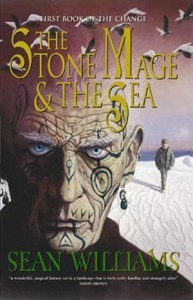 34. The Stone Mage and the Sea, Sean Williams (2001)
34. The Stone Mage and the Sea, Sean Williams (2001)
This and the other Books of the Change were important to me because of the strong and very Australian landscape that formed part of the worldbuilding. It wasn’t the first time I had come across that particular technique used, but it’s particularly strong in this trilogy. I’ve never been to South Australia, but there’s still a familiar culture for me about these books, from the red sand and Australian fauna to the vocabulary and characterisation. It doesn’t always have to be a medieval anglo fantasyland where North means cold and South means hot…
35. The Kushiel Trilogy, Jacqueline Carey (2001-2003)
Sometimes epic fantasy is about sex instead of swords. Well, okay. There are also swords. I like it when the problems of the world need to be addressed with espionage and politics rather than a small team of special snowflakes with one giant weapon, and I liked the character material in these books very much, as well as the nods to Greek and Roman history along with a comfortable mish-mash of other historical and mythological cultures.
36. The Tir Alainn Trilogy, Anne Bishop (2001-2003)
I’ll admit to loving Bishop’s glamorous Black Jewels books as much as the next person, but this more sombre trilogy beginning with Pillars of the World presses many of my personal favourite epic fantasy buttons: a lone witch dealing with the Fae to help fight the persecution of her kind, and a story which spirals from the small and domestic to have much wider and dare I say EPIC consequences. Yes, I really like stories which address the fact that burning witches is a bad idea.
37. Second Sons Trilogy, Jennifer Fallon (2002-2003)
You don’t need sufficiently developed technology to fake magic in an otherwise primitive society – but a little knowledge can go a VERY long way, particularly if you are in the business of setting up an all-powerful religion to control everybody through human sacrifice. One of the great strengths of this trilogy is the characterisation, particularly the exploration of an intelligent hero who goes undercover with the Evil Overlords, and finds himself far too good at ‘faking’ being evil. Lion of Senet is the first book in this trilogy.
 38. Paladin of Souls, Lois McMaster Bujold (2003)
38. Paladin of Souls, Lois McMaster Bujold (2003)
I enjoyed The Curse of Chalion very much (the standalone fantasy novel to which this is a standalone sequel) but Paladin gets my recommendation because of how rare it is to have a middle-aged mother as the central character of an epic fantasy, as well as a woman who has been marked out as ‘mad’ by most of society for a long time. Having a sympathetic protagonist who is also quite religious is rare too, because of the tendency towards most organised religions in fantasy novels being Evil. Also, I love siege stories. SIEGE!
39. The Anvil of the World, Kage Baker (2003)
Another trope I really love is the hard-bitten former devil-may-care type who is trying to retire gracefully, and can’t. Which is weird because I imagine it would be extremely annoying if it happened to me personally. Kage Baker was a writer with a particular knack for likeable, engaging characters who exchanged awesome banter. This was her first fantasy, about Smith the retired assassin, and the grand (occasionally wacky) journey he is dragged on against his will. Demons, disasters and best of all, an epic fantasy that begins and ends within the pages of a single volume.
40. Inkheart, Cornelia Funke (2003)
Translated from German, this gorgeous children’s fantasy uses books as the talismanic objects and sources of magic we always knew they were. The travels in and out of Inkworld continue in grand fashion for a whole trilogy, but it is the first book which really made an impact on me.
41. The Doctrine of Labyrinths, Sarah Monette (2005-2009)
Just when I thought I handle on epic fantasy (and I really wasn’t interested any more), along came Sarah Monette and Melusine. Dark, sensual and unabashedly literary, the journey of the tortured, aristocratic magician Felix and the grumpy, common-as-muck Mildmay captured me for the whole run. I loved all of these books, particularly for the sinister artistry of the cities that Monette built for her readers, and the just plain beautiful writing, but I have a particular attachment to The Mirador because of the addition of the actress Mehitabel as a foil for the two men. 42. Kingmaker, Kingbreaker, Karen Miller (2005)
42. Kingmaker, Kingbreaker, Karen Miller (2005)
This debut fantasy series consisting of The Innocent Mage and Innocence Lost (The Awakened Mage in the US & UK) is one of the best arguments you’ll ever see for the fantasy duology to replace the trilogy (and I’m a major trilogy apologist). Miller spends the first book building up an entertaining cast of characters, with a positive tone and a fun, adventurous spirit. She then proceeds to rip her reader’s heart out through their ribcage, from a literal cliffhanger ending to Book 1, and a devastating demolition of so much of what she had built in Book 2. It’s like all possible facets of epic fantasy wrapped up in a cheeky, soul-destroying bow!
43. The Privilege of the Sword, Ellen Kushner (2006)
Another fantasy without magic, and one I am desperate to reread now I’ve finally got around to reading Swordspoint. The best epic fantasy is that which conveys a strong sense of imagined history – it doesn’t matter how detailed your society is if it feels like it just got here. The Privilege of the Sword might be a sequel, but I read it as a standalone and I loved the powerful sense of what had gone Before in this city, as well as the complex relationship between the characters and their swords. Call it mannerpunk all you like, but if you’ve got sword training, the politics of a pretend city, a Mad Duke and this much swashbuckle, I’m going to call it Epic.
 44. Temeraire/His Majesty’s Dragon, Naomi Novik (2006)
44. Temeraire/His Majesty’s Dragon, Naomi Novik (2006)
Hello Napoleonic War, have I introduced you to DRAGONS? Sometimes stories set in our world are just plain epic enough to count, and once you add people riding in dragon harnesses to your alternate history, I think it becomes another thing. The relationship between Laurence and Temeraire in this first volume is particularly heartfelt and interesting, and I have to say these books have some of the most gorgeous fantasy covers of the last decade.
45. The Watergivers/The Stormlord Trilogy, Glenda Larke (2009-2011)
Over the last couple of years, I have returned to reading epic fantasy with new enthusiasm. This amazing trilogy beginning with The Last Stormlord did a lot to lure me back to the genre. Inspired at least party by the author’s travels through Tunisia, the trilogy also feels very Australian with its hot temperatures and dire drought. This is a land where the only way to bring rain is to use magic, and unfortunately the old Stormlord’s heirs have suffered a spate of suspicious deaths over the years, which puts the whole kingdom in a very precarious position. I love the female characters and gender issues explored in these books, particularly the pregnancy of one of the point of view characters, but honestly there’s so much good old fashioned war, politics, magic, backstabbing and end-of-the-world drama in this story that it should have very wide appeal. There’s also a charming ‘magical art’ subplot that becomes more and more significant as the story goes on. So, so good.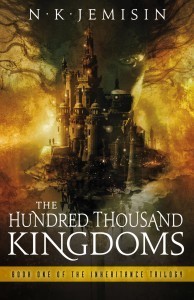 46.The Hundred Thousand Kingdoms, NK Jemisin (2010)
46.The Hundred Thousand Kingdoms, NK Jemisin (2010)
This first volume of the Inheritance trilogy (each of which serves as a standalone with a new protagonist) set up a strange and disturbing world in which the gods live like kings in a floating city, and a young heir is rudely introduced to her bizarre, dangerous family and the nasty, murderous political game they play against each other. It’s basically epic fantasy by way of the gothic novel, and not just because the hero is a girl. Everything outside the palace (AKA the mysterious and seductive house) feels faintly unreal, but that only goes to make Yeine’s peril in the palace feel more intense. Apparently some critics were a bit distressed the amount of saucy bedroom time in this book which only goes to show they hadn’t been reading the same epic fantasy that I had for the previous decade and a half…
47. Cold Magic, Kate Elliott (2010)
Kate Elliott has put together some spectacular worldbuilding (with the rise of the Phoenicians as a culture as far as Britain, and a mashup of Celtic and African traditions, to mention just a couple of details from her complex web) and a substantial history behind our heroine as she embarks on her adventure. There’s a steampunk sensibility about this book, largely coming from the time period being a bit later than Earth-ish epics tend to be (18th-19th century dominant rather than medieval, Renaissance or Tudor) but the storytelling aspect is good old fashioned epic fantasy in many positive ways (lots of travel, arranged marriages, ice and snow, scary magic and potential-end-of-the-world politics, a central protagonist with a lot to learn and a heavy weight on her shoulders) – and also mould-breaking in even more positive ways (a world that allows for actual racial diversity as a matter of course, some lesser-used historical influences, female friendships, and some interesting male-female dynamics.
 48. Who Fears Death, Nnedi Okorafor (2010)
48. Who Fears Death, Nnedi Okorafor (2010)
This novel is many things. It has shades of science fiction, for a start, in its remnants of computers and other technology worn down to the wires. It has the weight of history, particularly the history and culture of the Sudan. But mostly it is fantasy, the kind of fantasy that makes you feel bad for the rest of the genre because it can’t possibly compete. The protagonist, Onyesonwu, is born of war and rape, and as she comes into adulthood she goes on a quest to understand the magic she has inherited, rallying support around her as she builds her strength before facing down her villainous sorcerer of a father. If this is not epic then honestly, nothing else is.
49. The Outcast Chronicles, Rowena Cory Daniells (2012)
Matriarchal societies are surprisingly rare in epic fantasy, which tends towards the medieval mode as a default for everything – but especially social models. In this series, Daniells builds a clever society of magic-users and artisans (with discreet but ‘necessary’ underpinnings of slavery and sacrifice) which she then demolishes, one nuanced stroke at a time, by taking away everything they care about and forcing them to examine and re-examine every privilege from first principles. On boats.
 50. Princeless, Vol. 1, Jeremy Whitely (writer) & M. Goodwin (art) (2011-2012)
50. Princeless, Vol. 1, Jeremy Whitely (writer) & M. Goodwin (art) (2011-2012)
Finally, a comic! There aren’t many epic fantasy comics out there, and even fewer that I’ve actually read (though I am hoping Gail Simone’s Red Sonja proves as promising as the covers suggest) but my discussion of essential epic fantasy wouldn’t be complete without mentioning this four-issue limited series, which was released October 2011 – February 2012. It was later put together in a book which sadly (like the issues themselves) is almost impossible to buy in print if you live outside the US. Lucky for me, ComiXOlogy came to the party. The second volume has started being published, so it’s an ongoing narrative, but the first four issues tell you all you need to know about whether Princeless is for you, or the kid in your life, or both.
Princeless is one of many, many stories which subvert the trope of ‘girl meets dragon’ by having the girl and the dragon join forces, often against the knights sent to kill the beast. The subversion is almost as old as the story itself – or maybe it just seems that way. But Princeless is the book I wanted to represent that particular trope because of its clever writing and gorgeous art, its visual as well as narrative explosion of gender and race expectations in fantasy, and because – well. It’s recent, it’s awesome, and it’s for kids. The kids who read this comic may well be the same kids picking up epic fantasy for the first time when they hit thirteen or fourteen (if not before), and this book will show them right from the start that they don’t have to settle for books where the slightly dumb young hero is always a farm BOY, or worlds that are full of dragons but have no characters who aren’t white, or book covers featuring young ladies dressed in ‘the Sonja’.
It’s a book about sensible armour, about how blacksmiths sometimes have to deal with as much gender shit as princesses, and that really important question about who the hell puts up with a king who thinks locking his daughters in towers is a reasonable lifestyle choice? It’s about how dragons are people too, and young men often suffer as badly from patriarchal expectations and traditions as the young women around them – though, not quite as badly, even when it’s pretty miserable for them. Because, the lack of towers and dragons.
Princeless is a story about a young person who HATES her chosen destiny, and decides not only to fly in the face of it, but to start upon her life of rebellion by rescuing all her sisters from their chosen destinies too.
THE END.
PHEW, so that’s my list. As you can tell, I’m not good at keeping things brief. Thanks for reading this far.
If I didn’t include your favourite epic fantasy, it’s probably because I haven’t read it, or I haven’t read enough of it to feel I can count it in this particular list. Or, you know, maybe you liked it more than I did! Happy to discuss my (and your) choices in the comments.
Books I wish I had found room for in the list include Lavinia by Ursula K LeGuin (if only because I feel bad for leaving LeGuin out, but I never got the hang of Earthsea and it feels silly to put Lavinia in when The Aeneid is already there – though I recommend you read both books together!), Tooth & Claw and/or Lifelode by Jo Walton (both excellent, and I would not argue with anyone who wanted to justify them as epic fantasy), and that first one by Terry Goodkind (which I seem to remember was pretty good. Movies that I almost included were Willow and The Princess Bride, but they both got bumped to find space for more books.
I feel especially guilty for not having read enough Sara Douglass or Trudi Canavan to give them pride of place in the list considering their massive success and popularity internationally, and that both of them have led the way in shaping the epic fantasy genre in Australia. I also would have liked a spot for Sean McMullen, who was writing weird, Aussie epic desert-ish fantasy with librarians long before the big Australian publishers had figured out that thick books with magic and swords were a good thing to print – and has written some pretty epic stuff in recent years, too.
But, hey. It wouldn’t be a really awesome list if you hadn’t left a bunch of awesome stuff on the cutting room floor, right? Chances are I will kick myself for forgetting something EVEN MORE IMPORTANT at some point in the next week.
Now, if you’ll excuse me, I have some re-reading to do…
June 7, 2013
Epic List of Epicness: 50 Essential Epic Fantasies Part I
 So, I received a challenge recently. A challenge so enormous that it seemed insurmountable. I love these kinds of challenges (this is not an invitation to send me more challenges, I am totally challenged out for the month!)
So, I received a challenge recently. A challenge so enormous that it seemed insurmountable. I love these kinds of challenges (this is not an invitation to send me more challenges, I am totally challenged out for the month!)
The challenge was this: to make a list of 50 Essential Epic Fantasies, to be posted in two halves at the same time as other challengees.
The rules:
• No more than one book or series from each author (for example, Tolkien can go in for The Hobbit or The Lord of the Rings or the Silmarillion)
• No collections or anthologies
• You can only list books that you have read.
• Definition of “essential” and “epic fantasy” up to individual interpretation.
The other people rising to this particular EPIC challenge are: Jared Shurin, Justin Landon and Liz Bourke.
So, phew. Let’s start by looking at that question of ‘essential.’ I wanted to include (mostly)books that were personal to me, and that helped shape my vision of the genre of fantasy as a whole and epic fantasy in particular. To that end, though it didn’t start out that way, the list has gone vaguely chronological. For the most part, the books in this first 25 represent the books from my teen years, or the very early years of the genre, i.e. Before I discovered that Australians Could Write This Stuff Too.
This, then, is my list of Tansy’s Essential 50 Epic Fantasies, the ones I am most glad that I read and have contributed to my sense of the genre.
Please distribute, debate and discuss the list – and feel free to try the challenge yourself!
PART ONE: THE FIRST 25
Lookin’ kind of blonde there, Mara. (the first white-washed cover I ever noticed!)
1. The Empire Trilogy, Raymond E Feist & Janny Wurtz (1987-1992)Still the trilogy that all other epic fantasy has to live up to, as far as I’m concerned. World politics, fighting, marriage and domestic drama, commerce, espionage, war, sex, cultural clashes and amazing fashion, with the fate of the world resting on the shoulders of one woman. Neither of these authors ever wrote a book that affected me anything like the story of Mara, Daughter of the Empire.
2. Legend, David Gemmell (1984)
Aww, Druss. This intense standalone novel (yes it became a series, never mind that, STANDALONE EPIC FANTASY HERE) revolves around a rather grim siege, with an unforgettable grizzled war hero at the centre of it all. The book practically drips with traditional masculinity, but even here in his debut novel, Gemmel was already poking away at the idea of how legends become legends, and what exactly is the point of having heroes anyway?
3. The Belgariad, David & Leigh Eddings (1982-1984)
You might have had one of those other quite famous series involving Hobbits, Magicians or Shannara as your First, but this was the epic fantasy series that taught me what epic fantasy looked like as a genre. With the Will and the Word, the Eddingses insisted their magic have immediate consequences. Also: Belgarath was my first cranky elderly sorcerer, Polgara was my first motherly but eternally beautiful sorceress, Garion was my first farm boy, Silk was my first nimble thief… you get the picture, right? Readable (though I suspect not overly re-readable), funny and undoubtedly epic. May contain wolves.
4. The Chronicles of the Cheysuli, Jennifer Roberson (1984-1992)
Dynastic politics, shapechangers, swords and prophecies. Oh and many, many angsty wolves. This fantasy family saga showed how a hated and reviled magical race could go from rags to riches, from exile in their own land to the shinest throne in the palace – and while the gender politics are very 1980’s, the characters have stayed with me over the last (gulp) 20 years. I came *this* close to naming one of my daughters Alix.
my copy looks way more battered than this
5. Mists of Avalon, Marion Bradley (1983)It doesn’t get much more epic than the Arthurian saga, and this version with its focus on the female characters gives Game of Thrones a run for its money: grisly deaths, emotional drama, politics, religion, magic, incest, chivalry, heraldry, betrayal, and of course the rise and fall of one of the most famous kingdoms in British history.
6. The Swords of Lankhmar, Fritz Leiber (1968)
Sword and sorcery, not epic fantasy, you say? Pfft, I say. I’ve never seen the point of separating those two variations of the fantasy genre, and given the grimdark direction that a great deal of epic fantasy has gone in recently, I think it’s ridiculous to suggest that the adventures of Fafhrd and the Grey Mouser (and the gritty, bleak and yet colourful society around them) aren’t direct ancestors and influences now (though of course, they always were). Of all the possible works, I picked “Swords” because I feel their adventures at sea have a particularly epic quality, plus intelligent rats with swords. Because intelligent rats with edged weapons! What’s not to love?
7. The Adventures of Alyx, Joanna Russ (1976)
The fascinating appeal of this book is not that it feels in any way like an epic fantasy, but in the way that the stories react against the traditions of fantasy heroes. Considering how active the conversation is these days about the portrayal of women in fantasy fiction, these stories (and “I Thought I was Afeared Till She Stroked My Beard,” “Bluestocking” and “The Barbarian” in particular, add so much to that conversation. I think these stories have as much to say about the fantasy fiction that came after they were published than they do about the fiction that came before which is quite an achievement!
(Yes I know the rules said no collections, but this is treated as a mosaic novel by many and also SHUT UP JOANNA RUSS IS JUDGING YOU)
oh Dragonlance, the candied popcorn of epic fantasy
8. Dragonlance Chronicles, Margaret Weis & Tracy Hickman (1984-1985)Oh yes, I went there. I loved Dragonlance like pie when I was in my first ‘reading without discrimination’ phase of fantasy discovery, and it introduced me to many of the tropes and traditions of the genre. Admittedly those traditions were also the ones I later railed against when I got sick of the whole genre around the time I hit 17 and started writing sarcastic comic fantasy instead… What Dragonlance did very effectively, though, was to humanise its villains (Oh Kitiara, I still love you) and present some pretty flawed heroes and anti-heroes into the mix. Oh and did I mention all the women with power in this story? The weird, screwed up relationship between brothers Caramon and Raistlin is something that wouldn’t be at all out of place in a modern ‘grimdark.’
9. The Odyssey, Homer
Of all the classical works, The Odyssey is the closest you’ll get to a clear epic fantasy. Our lone, grizzled anti-hero sails around in circles in the desperate hope of reaching his home and his wife, shagging magical women and killing magical monsters in a seemingly endless series of Golden Age anecdotes which resolve finally in him invading his own home, and rescuing his beleaguered wife. Honestly, it SOUNDS like it was written in 1982 and it deserves a Boris Vallejo cover.
10. The Aeneid, Virgil
A little more staid and less trashy than my beloved Odyssey, The Aeneid has a whole lot more war and family politics going on, plus one of the best and most vivid ‘going into the Underworld to gain wisdom’ subplots of Western literature. Essentially a reboot of the Iliad and the Odyssey told in reverse, with all the bits that didn’t appeal to Romans ironed out, The Aeneid reflects the same gender problems as much early epic fantasy but does make quite clever use of the dramatic flashback.
11. Song of Sorcery, Elizabeth Scarborough (1982)
The quest of a hapless minstrel, a cranky and pragmatic young witch, with nothing much more at stake (at first) than the reputation of her runaway sister. But while the scope of the novel makes this one perhaps a less obvious candidate for a list about EPIC fantasy of EPICness, it is a great example of how a small, domestic and personal quest can snowball into a much larger story involving castles, dragons and a kingdom on the brink of war.
I see your grimdark and raise you a couple of grinning wizards playing dice…
12. The Black Company, Glen Cook (1984)Another example of the epic made personal through a single narrative is the first Black Company novel by Glen Cook. Narrated by the well-meaning and slightly-less-evil-than-everyone-else Croaker, this tells the story of a gritty mercenary unit, and what happens when they are employed by Lady, a ruthless and powerful ruler. It’s a weirdly dissociative book to read, not helped by the fact that nearly every character has either a proper noun or an adjective as their name, and that Croaker himself admits on occasion to be something of an unreliable historian of events. But the darkness, creepiness and epic nature of the war is balanced out by an oddly domestic look at the life of a soldier… and oh, there were far more epic adventures to come!
13. The Green Lion Trilogy, Teresa Edgerton (1989-1990)
Starting with Child of Saturn, this trilogy depicted kingdom politics in a Welsh-Celtic fictional world with a particular interest in linguistics (Tolkien wasn’t the only one to invent a language!) and alchemy as well as the more usual medieval fare: knights, queens, romance and evil schemes, in a setting that felt like it MUST have existed somewhere.
14. The Fionavar Tapestry, Guy Gavriel Kay (1984-1986)
My second (sort of) Arthurian entry for the list! To this day I haven’t read any other Kay novels, though I feel more and more that these are books I need to read. Beginning with The Summer Tree, five ordinary young college students are drawn into a magical world with some very familiar narrative threads woven through it – not just from the Arthurian cycle but Norse mythology and other legends too. But free will remains important, and just because you seem to be treading in the footsteps of a famous mythological character doesn’t mean things can’t go differently this time… which is really good news if it turns out your name means ‘Guinevere’!
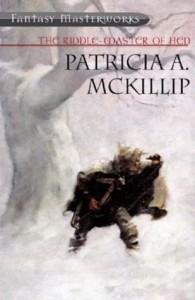 15. The Riddle-Master Trilogy, Patricia McKillip (1976)
15. The Riddle-Master Trilogy, Patricia McKillip (1976)
Another subversive take on epic fantasy (oh I do love those so much), this trilogy humanises princes and princesses (against the backdrop of a ruinous world) and presents far more ‘ordinary’ or domestic takes on epic situations, told with gorgeous, fluid language that evokes early epic poetry. Seriously, McKillip writes some of the prettiest prose in the business, and almost always uses it to distract you from clever, tight novel plots. It’s a crime that we don’t hear more about her in the history of the field. Swineherds, riddles and towers forever!
16. The Neverending Story, Michael Ende (1979/1983)
Just because it’s written for children doesn’t mean it’s not epic, of course. This German fantasy novel throws a small boy into the world of Fantastica via a beautiful and terrible book, and introduces us to some of the most vivid and terrifying set pieces in the history of the genre. Even kids who DIDN’T dress up as the Childlike Empress when they were 8 (guilty as charged) were terrified by the approaching Nothing – and for my generation, the 1984 film depiction of the death of a certain horse in a certain Swamp of Sadness was a defining moment of shared devastation.
17. Ozma of Oz, L. Frank Baum (1907)
The Oz books pretty much defined the narrative model of “a hero and his/her ensemble of unlikely and mis-matched comrades travel on a quest for talismanic items which will teach them about themselves and/or save society” and I could have picked almost any of them. But I have a soft spot for this particular book, the third in the series, which takes place largely outside the colour-coordinated magical land, widens the scope of the stories that could be told in the Oz universe, and features not only a slightly older and wiser (and less keen to go home) Dorothy, but also some of my favourite iconic characters/creatures of the series: Tik-Tok the gorgeous clockwork robot, and the terrifying Wheelers. Also, Billina the hen is the best comic sidekick ever.
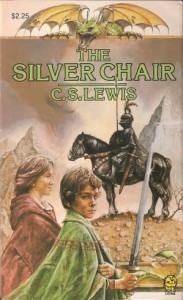 18. The Silver Chair, CS Lewis (1953)
18. The Silver Chair, CS Lewis (1953)
Choosing which Narnia book (I refused to cop out with the whole series) most represented the genre of epic fantasy took a lot of very serious thought. But ultimately, this one is the quest of all quests for me – the Lady of the Green Kirtle might not have quite the iconic staying power of Jadis the White Witch, but she has her own seductive charm, plus there are giants and serpents, lost princes, the Underworld, a gloriously glum marshwiggle, and jolly platonic school chums who call each other by their last names. My other main contenders for this slot were The Voyage of the Dawn Treader, and The Lion, The Witch and the Wardrobe, though my actual favourite is The Magician’s Nephew. (I reserve the right to change any and all opinions next time I re-read them all) We shall not speak of The Last Battle.
19. The Immortals, Tamora Pierce (1992-1996)
Let me introduce you to Veralidaine Sarrasri! This plucky heroine can talk to animals and I SEE YOU TURNING AWAY ALREADY but wait, there’s more. Tamora Pierce’s books may be aimed at a teen audience, but they do so many things that I wish most adult fantasy would at least try to do (like hello, let’s have a talk about magical contraception). I love all the Tortall books, especially the two series of ‘lady knight’ adventures, but Daine’s story is especially epic, showing her development of ‘wild magic’ and how this affects the kingdom around her, distant lands to which she travels in service to her king, and the Divine Realms themselves. Definitely contains wolves.
20. The Tough Guide to Fantasy Land, Diana Wynne Jones (1996)
Diana Wynne Jones’ speciality was the domestic drama with creeping magic, as well as the magic drama with creeping domesticity, though she also wrote some quite definitive ‘magic student/school’ stories and one of the best ever fictional depictions of a science fiction convention. But she also wrote several books which count as epic fantasy – The Merlin Conspiracy, those slightly dull Dalemark books (sorry), and her two comic fantasies, The Dark Lord of Derkholm and Year of the Griffin. HOWEVER, the latter two were basically amusing extrapolations of her most substantial contribution to Epic Fantasy, and the book no writer of this genre should ever allow themselves to be parted from. The Tough Guide to Fantasy Land is the TV Tropes of Epic Fantasy, and whether she is lecturing you on treating horses like cars or the properties of ‘stew,’ it is clear how immersed Jones is in the genre and how stern her challenge is to ‘do better.’ It’s also one of the most entertaining and amusing reference books of all time. 21. Incarnations of Immortality, Piers Anthony (1983-1990, 2007)
21. Incarnations of Immortality, Piers Anthony (1983-1990, 2007)
I know, I should have chosen a Xanth book. I wanted to choose a Xanth book. It would be honest to my teenage reading history – but while Xanth contributed so greatly to my early understanding of what could be done with epic fantasy on a smaller scale, packed with fun female characters and glorious classical monsters and finally a world not based on medieval traditions… well, I’m not twelve any more, so I look back on them and all I see is panties.
The Incarnations, though, while being set in a version of ‘our’ world, is the closest Anthony ever came to a really dark and complex epic fantasy saga – and I think that’s a more useful label for those books than a retroactive ‘urban fantasy’ stamp. It’s not our world – the books that dip into the history and the future make that pretty clear as do the present ones – but the narrative of the Incarnations is gorgeously woven around its protagonists. My favourites are still Chronos, who travels backwards through the timelines of the other books and characters, and Niobe, who spun green threads as both the Maiden and the Mother. But Death and War are also pretty entertaining characters.
I don’t think any fantasy book series has ever been quite as clever as this one was about weaving separate narratives into a coherent arc that defies chronology, reveals new perspectives to characters from book to book, constantly changing your expectations as a reader about what the hell is going on. All with a mixture of traditional and modern mythology, jammed up together. No wolves, but plenty of magic and swords.
PS: I suspect largely that re-reading these books would not be a pleasant experience for me. Also, I read these long, long ago and while I’m aware that an eighth novel was added to the series in 2007, I haven’t read it.)
22. Medea, Kerry Greenwood (1997)
Speaking of our world – let’s go back to the classical times of gods, monsters and a really DIFFERENT definition of the word ‘hero.’ Kerry Greenwood’s historical magic epic about Medea, which gives us a villainous but sympathetic and non-monstrous take on the famous witch, has so much to say about epic fantasy as a genre, and how it intersects with the epic hero stories of our cultural past. Not only Jason but Heracles and other famous mythological characters get stripped back to their mythical origins and re-examined with a hard eye, as does the historical tradition of Medea herself. Lovely stuff.
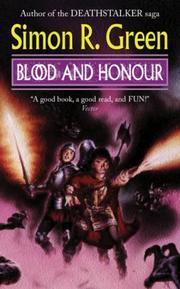 23. Blood and Honour, Simon R Green (1993)
23. Blood and Honour, Simon R Green (1993)
Simon R Green was one of my favourite authors in my teens, and a major influence on my work. I don’t really know why I stopped reading him. I don’t think any of his books were ever a disappointment to me, but the new titles sounded less interesting as he moved into urban fantasy instead of epic fantasy & space opera and so I stopped. His epic fantasy was always far more subversive and snarky than it looked, whether he was taking on fairy tale tropes or dark magic police procedurals – and in more recent years my head exploded one more time when I discovered retrospectively that yes, Prince Rupert and Princess Julia from Blue Moon Rising WERE HAWK AND FISHER. He’s also never hesitated when it comes to putting a sword in a woman’s hand and kitting her out with armour that covers all the relevant bits, which doesn’t hurt at all.
Blood and Honour, the Green epic fantasy that has most stuck with me over the decades, takes place entirely inside a murderous castle, and tells the grim story of warring heirs and bloodthirsty court politics through the eyes of an actor who is hired to take the place of an ailing prince, and soon finds himself up to his neck in, well. Shit, really. It’s like Game of Thrones meets The Prisoner of Zenda, only there’s a room that eats people. I love it. I need to re-read it. Simon R Green party everyone!
24. Sometimes The Magic Works, Terry Brooks (2003)
I never read Shannara, and while I did read a lot of the Magic Kingdom For Sale books, I’m not going to recommend them to anyone. Some of your teen reads you’re happy to own and defend, and others can just go quietly off to the big second hand bookshop in the sky. But by far the most interesting epic fantasy work I’ve ever read of Brooks is his collection of essays ABOUT writing epic fantasy. Wonderful, inspiring and historically important stuff, and it almost makes me wish I’d given Shannara a go when I was young enough to eat them up with a spoon.
Young lady, what do you mean I stole my look from Belgarath the Sorcerer?
25. Lord of the Rings, JRR Tolkien (1954-55)Hooray! A surely-not-controversial entry! No one can deny that this one is an epic fantasy of note. I will add that I didn’t read LoTR until my 20’s, and I once got hissed at on a fantasy panel at a convention when I admitted I hadn’t read them. I WATCHED THE MOVIE FIRST, PEOPLE. On the other hand, I did get through Books 2 and 3 in a single day (while travelling through Nottingham, sorry, Nottingham) and my honey came home to find me bawling my eyes out over the appendices, because it listed when each character (eventually) died. “THEY ALL DIE!”
And now, before I run away to compose the second half of this list for Monday’s post, I want to note that the large majority of the books in this first list were discovered and consumed by me between 1991-1995. That is, my high school years.
Something really important happened to me in 1995. I was in Myer looking at the (few) bookshelves and I came across a title called The Madigal by Beverley MacDonald. I don’t remember anything about the contents of the novel itself (though I do know I bought it) which is why it isn’t included in my list, but it was the copyright page that blew me away. Because that was the moment I discovered that AUSTRALIAN WRITERS WROTE EPIC FANTASY. More to the point, they sometimes got it published BY AUSTRALIAN PUBLISHERS. Now, this was probably about five minutes before Harper Voyager published Sara Douglass, so it wasn’t going to be long before this was duh, old news, but to me it was a revelation.
Because yes, I had been writing an epic fantasy of my own since I was thirteen, but it had always seemed a bit pie-in-the-sky because it was obvious that all fantasy authors were English or American and what little I had seen of the internet so far had been quite small and limited.
And now, suddenly, the world looked very different.
So come back on Monday to see me talk about many, many Australian epic fantasy novels, and other authors/books that came to me in my adult years…
June 6, 2013
Friday Links is Short and Sweet (this is a lie)
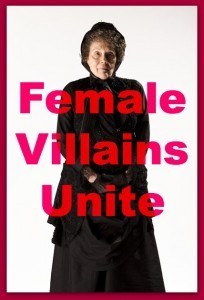 I was going to keep it short this week because I feel like I’ve spent the whole week doing nothing but curating links, and also because I have an Epic Post of Epicness coming up later tonight thanks to a blogging challenge, so I need to save my formatting strength. But then, you know, this happened.
I was going to keep it short this week because I feel like I’ve spent the whole week doing nothing but curating links, and also because I have an Epic Post of Epicness coming up later tonight thanks to a blogging challenge, so I need to save my formatting strength. But then, you know, this happened.
Speaking of Epic, there’s some mighty coverage of the Australian SF/Fantasy scene in the Guardian today – looking particularly at the recent signings of Ben Peek and Rjurik Davidson with Tor, but thanks to substantial quotes with Jonathan Strahan and Cheryl Morgan as well, there’s also some discussion of what makes Australian SF/fantasy different, recent awards, and our many successful female writers. Hooray!
The Guardian, both UK and Aus, has been covering spec fic really well this week – I can’t tell you how many people told me about this post about YA and Gendered Covers, which I am especially fond of because, you know, it linked to my blog! But also it’s full of very sensible discussion of an issue that won’t go away any time soon.
I’ve been thinking a lot about female villains lately, and so has the Mary Sue – which looks at the disappointing lack of female villains in modern action/SF movies and a few reasons why filmmakers might be running scared of the concept. Lucky we have Game of Thrones, eh? And I have to say, the last season of Doctor Who did pretty well in this regard. Lena Headey, Celia Imrie and Diana Rigg, you rock!
The Jezebel has published an open letter to white male comedians by female comedian Lindy West, which lays out in no uncertain terms why rape jokes are unfunny, hurtful, damaging and (possibly most important) CONSERVATIVE RATHER THAN EDGY. A wonderful, funny and significant piece. I found it particularly interesting that the language used to defend rape jokes in the stand up comedy scene is similar to that used to defend, oh sexist language in the SF publishing community? (I see your thought police and raise you a humourless feminist!)
Speaking of feminism, I really enjoyed this Feminist Defence of Steven Moffat.
Foz Meadows has been at it again, this time talking about the perception that women bring “romance cooties” to SF in The Huffington Post.
Meanwhile, Judith Tarr follows her spectacular take on the last several decades of the publishing industry by sharing her own more personal experience with What Happens When the Contracts Dry Up, and how she has recovered from her career stalling. This stuff is not talked about enough.
Oh and speaking of spectacular bloggers who have been doing great work lately, check out Kameron Hurley talking about Unpacking the “Real Writers Have Talent” Myth, and why finding writing hard is okay
Jo Walton’s speech from Wiscon: on Characters, Complicity and Caring (or: the many ways in which writers manipulate readers).
Cheryl Morgan writes an important post that any writer thinking about writing magical gender transformations should read – she’s not suggesting there’s anything wrong with those stories, but wants to make it clear that if you think they reflect the actual trans experience, you’re wrong.
Anyone who wants to know what the hell that whole Game of Thrones fuss was about earlier this week, and doesn’t mind being spoiled for the story (sometimes it saves time, right?) should check out the controversial episode as told through the noble art of the Facebook status.
Bitch Magazine on What I Learned About Gender and Power From Sailor Moon.
The Finnish baby box, and why it makes such a great and equal start for all babies in Finland. Wow. That would have probably worked a lot better than the Baby Bonus, Australian politicians!
Just in case you thought I had forgotten about the sexism and SFWA Bulletin issue (as if!) I bring you a lighter take on the subject, courtesy of the very over-worked but still Tweeting Vice-President Rachel Swirsky: A brief survey of the accomplishments of chappie writers and editors.
You know how Jim C Hines made the point about gendered covers by switching the genders to show the ridiculous indignity people took for granted when it came to women? Yep, this is the equivalent of that. But with less of a need for a chiropractor afterwards…
In closing, SUFFRAGETTE SITCOM BY JESSICA HYNES! Giving parts to a whole bunch of Britain’s funny (and older) female actresses! What’s not to look forward to about THAT? (is it too much to request appearances by Celia Imrie and Diana Rigg?)
Galactic Suburbia 82
New Episode is up! You can find it here.
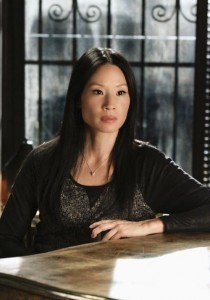 In which we talk sexism in the industry, feminist space opera, childbirth and babies in comics, space cowboys, and the hidden value of translators. Also, Watson is a girl now!
In which we talk sexism in the industry, feminist space opera, childbirth and babies in comics, space cowboys, and the hidden value of translators. Also, Watson is a girl now!
News and Links
The SFWA Bulletin Discussion:
Foz Meadows dissects the Malzberg/Resnick article causing most of the controversy and protest.
Jim Hines curates a massive list of protest blogs/tweets on the issue (though as he himself makes clear this is not a comprehensive collection of links to the entire debate, or every post on it – just the ones protesting the sexist attitudes published in the Bulletin, as proof they were not anonymous).
Ann Aguirre on her experiences of sexism in the SF industry.
Alisa’s Observations Part I & Part II
Tansy on Why It’s Important (And Why We’re Still Talking About the SFWA Bulletin)
New Women vs Tropes in Video Games: Damsels In Distress, the trope so widespread that this is Part 2 of a 3 part series.
Lambdas: the LBGTQ Literary Awards! Some speculative fiction representation there…
Culture Consumed
ALEX: Space Cowboys; Chase the Morning, Gates of Noon, and Cloud Castles – Michael Scott Rohan; Hawk and Dove, Karl Kesel and Barbara Kesel (5 issues, 1986); X-Men #1
ALISA: The Rook, Daniel O’Malley; Saga; Small Blue Planet Ep 4: Israel; Quick PhD update
TANSY: The Other Half of the Sky, edited by Athena Andreadis & Kay Holt; Elementary
Please send feedback to us at galacticsuburbia@gmail.com, follow us on Twitter at @galacticsuburbs, check out Galactic Suburbia Podcast on Facebook and don’t forget to leave a review on iTunes if you love us!



